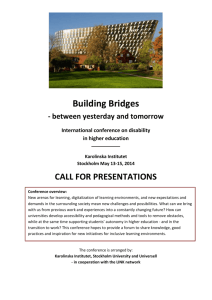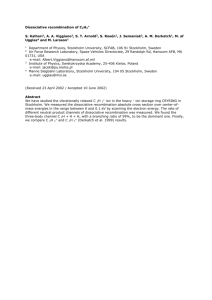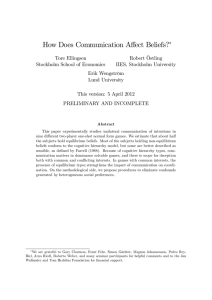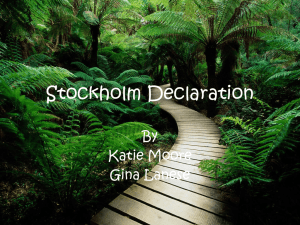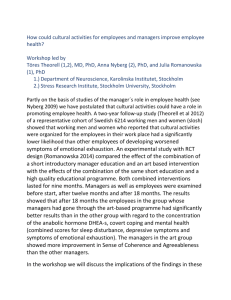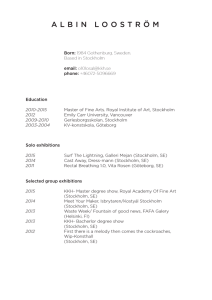Stockholm,Sweden
advertisement
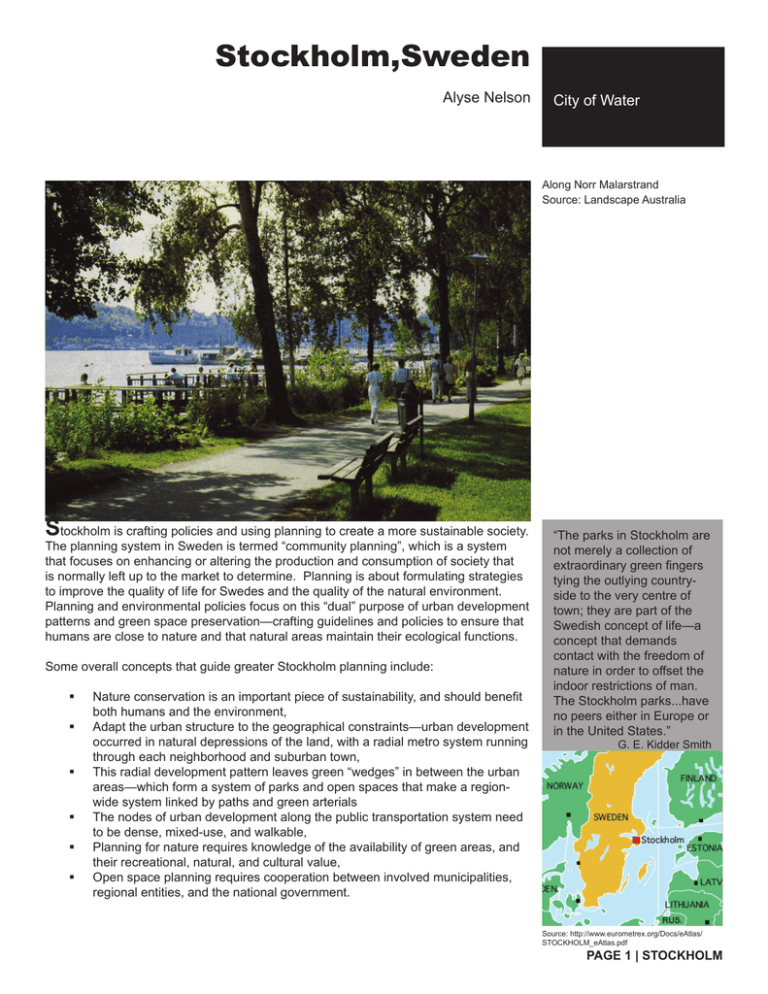
Stockholm,Sweden Alyse Nelson City of Water Along Norr Malarstrand Source: Landscape Australia Stockholm is crafting policies and using planning to create a more sustainable society. The planning system in Sweden is termed “community planning”, which is a system that focuses on enhancing or altering the production and consumption of society that is normally left up to the market to determine. Planning is about formulating strategies to improve the quality of life for Swedes and the quality of the natural environment. Planning and environmental policies focus on this “dual” purpose of urban development patterns and green space preservation—crafting guidelines and policies to ensure that humans are close to nature and that natural areas maintain their ecological functions. Some overall concepts that guide greater Stockholm planning include: ß ß ß ß ß ß Nature conservation is an important piece of sustainability, and should benefit both humans and the environment, Adapt the urban structure to the geographical constraints—urban development occurred in natural depressions of the land, with a radial metro system running through each neighborhood and suburban town, This radial development pattern leaves green “wedges” in between the urban areas—which form a system of parks and open spaces that make a region- wide system linked by paths and green arterials The nodes of urban development along the public transportation system need to be dense, mixed-use, and walkable, Planning for nature requires knowledge of the availability of green areas, and their recreational, natural, and cultural value, Open space planning requires cooperation between involved municipalities, regional entities, and the national government. “The parks in Stockholm are not merely a collection of extraordinary green fingers tying the outlying countryside to the very centre of town; they are part of the Swedish concept of life—a concept that demands contact with the freedom of nature in order to offset the indoor restrictions of man. The Stockholm parks...have no peers either in Europe or in the United States.” G. E. Kidder Smith Source: http://www.eurometrex.org/Docs/eAtlas/ STOCKHOLM_eAtlas.pdf page | Stockholm “One of the greatest threats against nature and parks in our cities today is that all too often, planning is shortsighted. . . The green structure of cities is being fragmented. We risk building into nonexistence the important links in a green structure which are needed to build a city based upon ecological principles.” - Sweden’s National Board of Housing, Building, and Planning City Statistics City Population: 762,882 (2004) City Area: 73 square miles (187 km2) Density Level: 16.3 people / acre Park Acreage: 21,000 acres (40% total land area) Park acreage per 1000 residents: 27 acres Governing bodies: ß City of Stockholm ß Stockholm County Council Context Planning has a long history in the Swedish society; the first planning laws were drawn up in the 19th century. In Sweden, planning is largely done by local governments, although the county and state can also be involved. Sweden’s planning system has three main elements: ß Democratic and decentralized decision-making, ß Competing interests are balanced, ß Ecological and social needs and values are taken into account. Timeline of Planning History: 1930s - Stockholm begins planning for a radial development pattern with green “wedges” in between 1945 - 20 year master plan for Stockholm crafted 1947 - Initial planning Act passed, concept of detailed development plans for key areas created 1952 - Metro network begins to be developed, new neighborhoods follow this network 1960s - Social Democrats in power, their planning model in full effect (a focus on the right to decent housing for all) 1987 - Urban Planning and Building Act revised, now cities are required to create a comprehensive plan (non-binding) 1995 - Sweden joins the European Union 1998 - Detailed development plans for dense areas are given legal force 1999 - CityPlan 99 sets forth the “Build the City Inwards” plan for infill development 2001 - Stockholm County Council approves its first spatial regional development plan for the greater Stockholm region. In the 1930s, The City of Stockholm began to develop a plan for their urban growth. They determined that growth should follow a public transportation system, forming long “fingers” of built areas with undeveloped “green wedges” left in between. This radial development pattern was continued throughout the region, providing easily accessible and ecologically-beneficial open spaces. This green network includes 10 long corridors, none less than 500 square feet in width. Source: http://www.eurometrex.org/Docs/eAtlas/STOCKHOLM_eAtlas.pdf page | stockholm City name tag line City of Water (arial 18pt) Major Components Stockholm’s land area is nearly 1/3 urban, 1/3 water, and 1/3 green space. Stockholm spreads over 14 islands, with 57 bridges connecting the city. There is a sound that runs through central Stockholm, which holds the largest number of fish species in the region. a. Connective corridors Stockholm features regional green wedges that connect from central city parks to the suburbs of Stockholm County wherever possible. These create both hu- man enjoyment, and aid in maintaining the natural bio-diversity of the area. b. Anchors There are 12 large parks in Stockholm, each over 200 acres. These account for 1/3 of Stockholm’s total open space. Ekoparken—This Park is the World’s first urban national park, established in 1995. The park’s total acreage is 6,670. Ekoparken is a typical Swedish park, in that it has both ecological value, as a home for rare insects and birds, and cultural value for Stockholmers. c. Neighborhood parks Neighborhood parks and community gardens account for nearly another third of Stockholm’s park system. d. Natural areas and Shoreline Wooded areas, and former farms that are publicly owned account for 1/5 of Stockholm’s open space. Eighty-percent of Stockholm’s shoreline is publicly accessible, often featuring walking and bike trails. e. Residential courtyards Green and Living courtyards program—The City of Stockholm will provide assistance for residents or property owners who wish to create a greener, sus- tainable courtyard for their residential building. Sources: http://www.miljobarometern.stockholm.se/Key.asp?mp=EP&mo=4&dm=3&nt= 5&uo=24 (above); Claes Grundsten/Bildhuset Swedish EPA (below) This map shows existing and future growth areas, as well as conservation sites. It also shows the existing and future transportation network. Source: http://www.eurometrex.org/Docs/eAtlas/STOCKHOLM_eAtlas.pdf page | Stockholm “No matter where you live in Stockholm, you’re no more than a half-mile from a park of at least 12 acres, designed with safe and convenient access.” - Cheryl Kollin Planning In Sweden, planning begins from a framework that respects the need to preserve the natural environment, both for ecological and human health. There are several documents that are significant to parks planning, including Stockholm’s City Plan and the Stockholm Regional Plan. While every city in Sweden is required to submit a comprehensive city plan, Stockholm is the only county with an official regional planning agency. The goals of these documents are to preserve the most valuable green areas within and outside of the city. One key priority in Stockholm is to focus on connecting these green spaces, both for human recreation and to promote biodiversity. Also, water is protected, and special attention is given to the entire watershed when planning for urban development. The green structure is to be supplemented by parks and open spaces within urban environments. In order to ensure that green areas are not destroyed in the name of urban growth, the City of Stockholm supports infill development in both their inner city and outer suburban communities. The Regional Plan has two key goals, 1) to develop regional nodes, and 2) to preserve the regional green structure. A Park Programme is being developed so that as infill increases urban and suburban densities, the amount of open space is maintained within and outside of the built areas. A sociotope map, which maps the socio-cultural valued open spaces provides a qualitative understanding of park users’ needs. There are also more definite prescriptions for the open space needs of the city: ß Within 200 m: green oasis, play, peacefulness, sit in the sun, walking ß Within 500 m: flowers, lively place, picnic, soccer ß Within 1 km: nature reserve > 50 ha ß Within 500 m: city district park 5-50 ha ß Within 200 m: park block 1-5 ha ß Provide open spaces < 1 ha wherever possible The Regional Plan recognizes that parks should be large enough to fulfill the needs of urban and suburban residents and be well connected in order to meet the dual purpose of environmental protection and human enjoyment. Initiatives The Green Map is another project that Stockholm is pursuing, in parallel with the City Plan 99. The Green Map’s purpose is to better define the green structure element of the City Plan. This map will make it easier to coordinate and plan for green space preservation and urban development. By better understanding the ecological and socio-cultural values of open spaces within the city, the Green Map will aid planners in guiding development away from important green spaces. This map will have both a ecological (biotope) component and a socio-cultural (sociotope) element. While the biotope mapping will show biodiversity and important ecological spaces, the sociotope mapping shows areas that are important places for human activity. The sociotope mapping experience has led the municipality to consider the location, purpose, and users of its open spaces and recreation areas. Citizens have been interviewed in order to better understand which places are important to show on this map. This Green Map project goes back to the dual purpose that Stockholm and Sweden expects from its open spaces: the biological function and the recreation component. Source: http://www.eurometrex.org/Docs/eAtlas/STOCKHOLM_eAtlas.pdf page | stockholm City of Water Lessons Learned Planning is a Cooperative Process Even during Stockholm’s most rapid period of growth, the City managed urban development according to their comprehensive plan. This plan was not legally binding, but was followed both within the City of Stockholm and its adjacent suburban towns. The reason that municipalities in the greater Stockholm region follow these non-binding plans is because they are created during a consensus-based process where private organizations, public agencies, and citizens are involved. This approach results in a plan that reflects an integration of these various perspectives. Plan for Density In Stockholm, dense areas that are established as targets for growth in the City Plan are given extra attention, as planners craft detailed development plans that mandate the type, form, and timing of development in that area. Then, as long as a development proposal meets the established plan’s criteria, it is automatically approved. Make Long-Term Investments Stockholm has not been afraid of making long-term investments within their city and region. They have laid an extensive metro subway system that has allowed the city to develop in nodes around the rail stations. New investments are being made, such as a light rail system to better connect the inner city with the metro system’s hub. These investments mean that only 22% of Stockholmers and 40% of residents in Stockholm County own a car. Don’t be Afraid to Preserve Nature Planning in the Stockholm region understands the necessity of preserving open spaces both for recreation and for human enjoyment within and outside of their city. By increasing density within urban and suburban nodes, natural areas can be saved. However, these open spaces are accessible and urban parks are provided in addition to these larger reserves. Sources: http://www.eurometrex.org/Docs/eAtlas/STOCKHOLM_eAtlas.pdf (above); Victoria Henriksson (below) Story in a Box: Build The City Inwards In the greater Stockholm region, the desire to preserve natural green areas and the need to expand as growth occurred were at odds with one another, and creating urban sprawl. Stockholm’s CityPlan 99 sets forth strategies for infill development and revitalization in order to better utilize the existing urban landscape and preserve the natural elements of the city and region. The plan names twelve specific areas within the central city that are prime for redevelopment, with strategies to create mixed-use communities in former industrial areas. This densification strategy also recognizes the importance of green spaces within the city, and no Stockholmer lives farther than a 5-10 minute walk from a 12 acre park. An example of this new infill strategy can be seen in the redevelopment of Hammarby Sjostad (Sea City). This is the first redevelopment area in inner Stockholm. The site was originally industrial, but had become vacant and run down. By 2010, 30,000 workers and residents will utilize the area, which is planned to be a dense, mixed-use urban node. Public transportation connections, in the form of a light rail and ferry system, will link Hammarby Sjostad with the center city and the regional metro network. This project is recognized world-wide as a sustainable development. Hammarby Sjostad will incorporate a new neighborhood park, in addition to being connected to the regional park system. While the City of Stockholm has in the past been a large landowner throughout the city and region, they are now running out of land to develop. While the City acquired a vast amount of land during the 20th century, it is now too expensive to buy more land. This is altering the role of the City in the redevelopment process, from the role of developer to that of a “go-between” as private developers invest in infill projects. The City ensures that redevelopment protects the public interest. Plan and perspective of Hammarby Sjostad Sources: In Lindberg, Goran’s article (above); http://www. stockholm.se/files/6860068699/file_68604.pdf (below) page | Stockholm “Five ‘wedges’ of woods and greenery extend from the outskirts of the landscape in towards the city nucleus. They constitute unbroken greenway stretches that pass between the radii of the city’s residential areas.” - Kjell Forshed The Polycentric Region: Seven Core Areas Greater Stockholm: Becoming a Polycentric Region Stockholm has developed based on a radial urban pattern, following public transportation routes out of the city. New towns have followed the same model, developing in dense nodes around rail stations. However, the Stockholm region has seen urban sprawl in spite of its impressive planning system. Urban sprawl has increased congestion and swallowed up some of the area’s green space. Now, the regional and municipal governments have created plans to alter this trend. The Regional Plan and Stockholm’s CityPlan both call for infill development within the urban core, especially on land that was once industrial and is now underutilized or vacant. In addition, the Regional Plan calls for a new spatial pattern--a polycentric model. This polycentric model would focus new growth in seven cores connected to the public transportation system at the periphery of Stockholm. These seven centers will eventually function as independent urban hubs, which will increase transportation and land use efficiency. Source: Munich-Stockholm comparison, www.rtk.sll.se Infill development locations within the City of Stockholm. Source: http://www.eurometrex. org/Docs/eAtlas/STOCKHOLM_ eAtlas.pdf Resources Source: Project for Public Spaces page | stockholm Ducas, Sylvain. Case Study of the City of Stockholm and the Greater Stockholm Area. Research Report to the Ville de Montreal, 2000. www.habitation.gouv.qc.ca/publications/M06301.pdf Friberg, Per. The parklands of Scandinavian cities. Nature in Cities. Ed. Ian C. Laurie. Chichester: John Wiley & Sons, 1979. Guinchard, Claes ed. Swedish planning: towards sustainable development. Gavle, Sweden: Swedish Society for Town and Country Planning (PLAN), 1997. James, Sarah and Torbjorn Lahti. The Natural Step for Communities. Gabriola Island, BC: New Society Publishers, 2004. Lindberg, Goran. Sjostadsparterren Hammarby Sjostad Stockholm. Arkitektur, 105(3): 55-59. Newman, Peter and Andy Thornley. Urban Planning in Europe. New York: Routledge, 1996. Office of Regional Planning and Urban Transportation. Munich-Stockholm: Comparison of the two regions’ planning systems and contents. Stockholm: Stockholm County Council, 2003. www.rtk. sll.se Office of Regional Planning and Urban Transportation. Regional Development Plan 2001 for the Stockholm Region: Short Summary. Stockholm: Stockholm County Council, 2002. www.rtk.sll.se Office of Regional Planning and Urban Transportation. Social Values in Urban Green Areas- The Green Wedges of the Stockholm Region. Stockholm: Stockholm County Council, 2005. Pemer, Mats. Developing a Sustainable Compact City in Stockholm, Sweden. New York, UN-Habitat Istanbul+5 Thematic Committee, 2001. http://www.unhabitat.org/istanbul+5/7-Sweden.PDF Sandberg, Eva and Bjorn Carlberg. Outings Guide to 10 Protected Natural Areas in Stockholm County. Stockholm: County Administrative Board of Stockholm, 2005. Stahle, Alexander and Anders Sandberg. The Sociotop Map of Parks and Other Open Spaces in the Inner City of Stockholm (part of Stockholm’s Green Map) - Methods and Results. Helsinki: GREENSCOM conference, 2000. Stockholm – Sweden: The Landscape of the City of Stockholm and The Continuous Park. Landscape Australia, 12 (1990): 9-13. Wood, Evan. Regional Planning in the Stockholm Area: An Evolutionary Process with National Implications. Plan Canada, 11 (1972): 228-243. City of Water Websites: ß ß ß ß ß ß ß ß ß ß ß ß ß Kollin, Cheryl. (2003). The face of the future: the United States and Sweden share the same goals for the environment. We can learn from each other’s means of getting there – Perspectives. American Forests. http://www.findar ticles.com/p/articles/mi_m1016/is_4_108/ai_97758009 Stockholm City Plan information http://www.sbk.stockholm.se/op/future.htm Stahle, Alexander. (2002). Urban Planning for a Quality Dense Green Struc ture; Stockholm Sociotop Map and Park Programme. http://www.map21ltd. com/COSTC11/sociotop.htm Parks and Gardens Information: http://www.stockholmtown.com/templates/Sub PageListing___2921__EN.aspx Stockholm’s Environmental Programme: http://www.miljo.stockholm.se/bilder/ pdf/mp_eng.pdf City of Stockholm: http://www2.stockholm.se/english Stockholm’s Ecopark (Djurgarden): http://www2.stockholm.se/english/cityof sthlm/cleanandgreen/ecopark.htm Swedish EPA: http://www.internat.naturvardsverket.se/ Hammarby Sjostaad: http://www.hammarbysjostad.se/glashusett/ Nature Conservation and Biological Diversity: http://www.sweden.gov.se/sb/ d/3879/a/23193 Stockholm Park System History: http://www.gardenvisit.com/ge/stock.htm Stockholm E-Atlas: www.habitation.gouv.qc.ca/publications/M06301.pdf City of Stockholm. Green and Living Courtyards. www.boverket.se/in_english/ swedishmunicipalities/environmetn-orientedwork/CityofStockholm11.htm Source: http://www.stockholm.se/ files/68600-68699/file_68602.pdf Tyresta National Park is made up of nearly 5,000 acres of virgin forest, only 12 miles southeast of central Stockholm. Source: Claes Grundsten/Bildhuset Swedish EPA page | Stockholm
